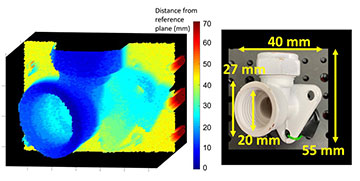Researchers developed a lidar system that uses quantum detection technology to capture 3D images while underwater. They demonstrated the technology by taking a 3D image (left) of a pipe (right). The scan was obtained in low scattering conditions with the single-photon system submerged in a tank. [Image: A. Maccarone, Heriot-Watt University] [Enlarge image]
Researchers in the United Kingdom, France and Spain have created an underwater lidar system that can capture 3D images in real time (Opt. Express, doi: 10.1364/OE.487129). While similar demonstrations have been performed with the optical setup outside a water tank, the current prototype successfully obtained three-dimensional videos of moving targets while completely submerged.
The novel technology, which is based on single-photon detection, could be used to inspect underwater installations such as offshore wind farms, to monitor or survey submerged archaeology sites, or for security and defense applications.
Leveraging single-photon detection
High-resolution optical imaging in turbid water remains challenging due to absorption and scattering, which cause significant signal attenuation in relatively short propagation distances. In previous work, Aurora Maccarone, Heriot-Watt University, UK, and her colleagues reported the first use of single-photon detection techniques for underwater imaging, which allows very high penetration through murky water.
“By measuring the time of flight of the light pulses, we were able to reconstruct three-dimensional images of underwater objects,” said study author Maccarone. “This [latest study] represents an advancement as, to the best of our knowledge, this is the first prototype of a fully submerged imaging system based on quantum detection technologies.”
Earlier experiments by her team and other groups were always performed in carefully controlled laboratory conditions, with the optical setup placed outside a water tank and data analysis performed offline. Now, not only is the optical setup underwater, but hardware and software developments made by Maccarone and her colleagues allow 3D images to be reconstructed in real time.
Moving the prototype underwater
The system included a green pulsed laser (532 nm, 20 MHz) for illumination and an ultra-sensitive array (192 × 128 pixels) of single-photon avalanche diodes for detection, along with a fiber collimation package, optical diffuser, lenses and bandpass filters. By measuring the return time of the reflected light, the distance to the target could be accurately measured.
The prototype achieved images of stationary targets at distances of 3 m, as well as real-time 3D video demonstrations of moving targets at 10 frames per second.
“The array of single-photon detectors gives the advantage of ultrafast low-light event detection, reducing considerably the time for operations in photon-starved environments, as in deep water,” said Maccarone.
After assembling and testing the optical setup on a laboratory bench, the researchers moved the equipment to a large water tank (4 × 3 × 2 m). They submerged the system in water and added a scattering agent in a controlled manner to make the water more turbid. The prototype achieved images of stationary targets at distances of 3 m, as well as real-time 3D video demonstrations of moving targets at 10 frames per second.
“Currently, the main challenge is to understand how to reduce the size of each component in order to integrate the imaging system on an underwater vehicle,” Maccarone said. “We are collaborating with industry to find a suitable solution to make this possible without compromising on the performance of the system.”

